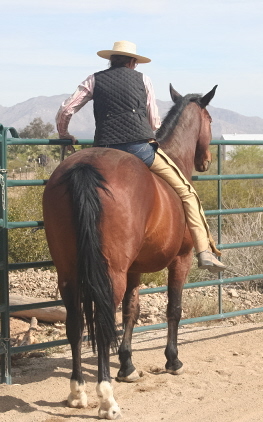 Ask the Expert is all about listening to horse-related questions readers and helping them expand their learning with advice from our partners, professionals who share a like-mindedness with BestHorsePractices and its principles. Got a question? Contact us!
Ask the Expert is all about listening to horse-related questions readers and helping them expand their learning with advice from our partners, professionals who share a like-mindedness with BestHorsePractices and its principles. Got a question? Contact us!
 For our first question below, we asked horsemen Elijah Moore and Libby Lyman.
For our first question below, we asked horsemen Elijah Moore and Libby Lyman.
Our Ask the Expert query comes from Nina Fuller at Lily Brook Farm in Hollis, Maine. She writes:
My question: I have a horse that was given to me two years ago. She’s great except for a few things. She won’t stop moving sideways and backwards when I go to get on. If I was younger ,I would just hop on. That’s what someone has been doing all her life. She is 18.
But now that I am not young, I want her to stand still so I can get on her when I am alone and no one is holding her. I have tried to put her against a rail or a fence, but she just wiggles away and avoids me as best she can.
Any suggestions?
Libby Lyman provides a Gentle Approach to Horsemanship in her clinics and private lessons, held in California, Maine, and  points in between. Check out her Maine clinics here.
points in between. Check out her Maine clinics here.
Lyman replies:
Sometimes a horse’s unwillingness to stand to be mounted can be associated with other riding-related activities. It may not be the initial source. Make sure you pay attention to catching, grooming, leading, saddling and bridling. See that the preliminary work has the horse relaxed and in a willing and learning frame of mind.
Also, bear in mind that some horses have a habit of walking off or being anxious because of the ride itself. People often ask the horse to walk off immediately after mounting, so horses learn to anticipate the pressure.
Stand for a moment with a relaxed rein before asking the horse to move off.
Often, a horse isn’t squared up before mounting, so they are in a habit of moving to re-balance while the person is mounting. Then, the person holds the reins tight to prevent the movement. But the rider misses that he or she has only prevented movement, instead of settling the horses mind to the job of standing.
You can help the horse by setting it up so that mounting is a place of release. It needs to be a spot on the planet where she finds comfort. If she walks off, or, is worried, make a little flurry of activity that will cause her to search for a different solution. Pretty soon, the horse will figure out that where she lines up to be mounted is the place of no pressure.
After working her in this way, don’t mount up immediately! Show her that it’s all good. Prove there is relief.
Some cautionary notes:
Riders may make three mistakes when hearing these instructions:
- Making the horse busy, but worried as well. Make sure you’re not getting yourself or the horse upset about it and that the horse gets relief for PREPARING to line up.
- Not gauging the appropriate pressure for the horse. Sometimes, what you’re asking for is almost nothing. Sometimes, you’ll use a whole bunch of intensity. It depends on the
 horse. Use as little or as much as it takes to motivate the horse to search for the answer. Reward the preparation not just the finished product.
horse. Use as little or as much as it takes to motivate the horse to search for the answer. Reward the preparation not just the finished product. - Some might succeed in training the horse to stand, but it’s not an act of free will for the horse. Instead, we want the horse to learn that it’s a good place. Not just a place where she has to be.
